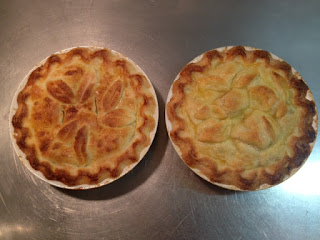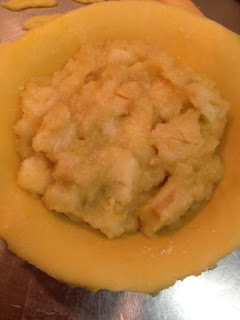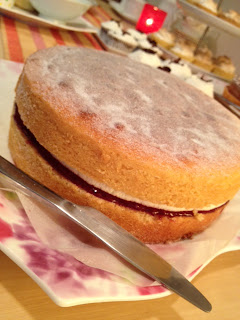 |
| Marzipan making night |
I made the marzipan I used on the Christmas cake from this Delia Smith recipe, which involves whisking egg yolks and sugar using a bain-marie. You can measure the temperature during the 12-minute whisking stage and make sure it either reaches 71°C or is maintained above 60°C for over 3.5 minutes to kill any salmonella that could be in the egg.
Most British recipes for marzipan contain eggs in some form, frequently raw as in the photos below, but if you check the ingredient list of most shop-bought UK marzipan you'll see it does not.
Indeed, in Germany where they have refined marzipan making to a national craft, eggs appear only rarely to be used. Many eggless recipes involve heating water and sugar, and sometimes glucose to a specific temperature and pouring the hot syrup onto the ground nuts.
 |
| Heated to 118C, this syrup became clear and bubbly |
I was interested to learn that there are specific legal requirements that need to be met in Germany to be able to call a product marzipan, including that it consists of at least 50% almond paste (marzipanrohmasse) which in itself can consist of only almonds, sugar and water and/or rose water.
The names 'marzipan' and 'almond paste' are often used interchangeably outside Germany, but it's probably helpful to think of almond paste as being a base for making the regular cake-covering/modeling marzipan (add more sugar). Almond paste is also used in baking and for making confections. Here is a breakdown of some of the different classifications of marzipan used in Germany.
Anyway back to the homemade stuff - I wanted to see what discernable differences there are between types of marzipan with/without eggs, cooked vs. raw, almonds vs *other nuts!* and so embarked upon a big making session followed by a blind tasting.
 |
| Serious stuff, this! |
I subjected my partner, who didn't complain too much, to a taste test before work one morning. We tried out the following marzipans:
A - Shop-bought in France, just before its best before date. A 'control', if you will.
B- Delia Smith's, a cooked version (if you measure the temperature to 71°C) with eggs.
C- Cottage Smallholder recipe, raw with eggs.
D- Dan Lepard's Pecan marzipan (but made with walnuts, for lack of pecans), cooked with eggs.
E- Peter Greweling's eggless recipe, but made with hazelnuts, cooked.
F- BBC Good Food's zesty orange marzipan, raw with eggs.
Our verdict was that out of the homemade versions, the Delia 'cooked' version had a texture that was closest to shop-bought marzipan, as it was drier and finer-grained. All of the raw marzipans were comparably wet and sticky, which was a lovely feature when used inside stollen, but could be challenging to roll out to cover a cake - I'd recommend being prepared to use a little more almond powder and sugar in either C or F recipes to combat that (particularly F).
The non-almond versions were lovely, especially the Dan Lepard version, D although I don't understand why both the glucose and the glycerine were necessary. Either way I'm now going to have to get more nuts to try the pecan version - maybe with bourbon. I'm also curious to have a go at something with just/mainly honey and almonds to see how that tastes and behaves.
D was a little crumblier in texture but I think that was more to do with the ground walnuts (done in a blender) being less uniform than the pre-ground almond powder I used for many of the other recipes. There is so much scope for variation - cardamon-flavoured Iranian toot, pistachio marzipan, cinnamon and other spices, pine nuts and perhaps trying something like one of my absolute favourite nut paste treats turron de jijona.
I also tried baking the marzipan to see if any of the different versions would melt away, and none did. It all browned quite quickly in a hot oven, and A and E (eggless) remained wetter inside compared with the other versions. Delia marzipan (B) was the firmest on baking and reminded me of the texture of white anko paste.. I'd say the Delia recipe is best eaten cold/used to cover cakes.
I now have a ton of marzipan :) Aside from covering the Christmas cake I'm experimenting using the different flavours to stuff my stollen loaves, using some to as alternative mince pie lids, and having slices of the walnut one in particular with glasses of sherry. Cheers!
If you're not interested in having a go at making your own, you can buy marzipan online in Japan from quite a few places as it turns out, starting with here and here. It’s most commonly called マジパン / majipan, which usually refers to the high sugar content type of regular marzipan we're all familiar with that's good for covering cakes (at least 50% sugar). Even if you are making your own you might still find it more economical to order your ground almonds and powdered sugar online too (Nissin supermarket almond powder is 980 yen for 350g and you can pay just slightly over 1,000 yen for about 1kg online).
You'll find almond paste / marzipanrohmasse referred to as マジパンローマッセ / majipan rohmasse or ローマジパン / roh majipan / raw marzipan. Both of these names refer to the higher nut-to-sugar ratio almond paste (2:1 nuts to sugar, with up to 35% sugar). Incidentally you can get the real thing - Lübecker marzipanrohmasse in Japan too, I'm definitely going to have to check some of that out!
The history of marzipan and its etymology are contested and fascinating. The tradition of kneading ground nuts with a binding agent such as honey goes back at least as far as 1800 BC Egypt, but the particular almond and sugar incarnation is claimed to be originally Iranian, or Chinese, Spanish, possibly Italian... There are stories in Arabian Nights of marzipan being used during Ramadan and of it being an aphrodisiac, and of it being transported to Europe by crusaders. Other origin stories involve resourceful Toledo nuns, inventive French cooks, and a day-dreaming Venetian baker's daughter making a mistake with a recipe. It was supposed to have been used as a palate cleanser at medieval banquets, in times when sugar and almonds were expensive it was a gift fit for royalty, then in the 18th century Germany it was given as a christening present.
Today the taste of marzipan appears to divide people almost as much as does coriander.
The unusual name is variously explained as coming from March bread, St. Marc's bread, little box, the king who sits still ..! To quote from the online etymology dictionary:
"marzipan (n.) 1901 (in modern use; earlier march payne, late 15c., from French or Dutch), from Ger. Marzipan, from It. marzapane "candy box," from M.L. matapanus "small box," earlier, "coin bearing image of seated Christ" (altered in Italian by folk etymology as though from L. Marci panis "bread of Mark"), of uncertain origin. One suggestion is that this is from Arabic mawthaban "king who sits still." Nobody seems to quite accept this, but nobody has a better idea. The Medieval Latin word also is the source of Sp. marzapan, Fr. massepain."


















































